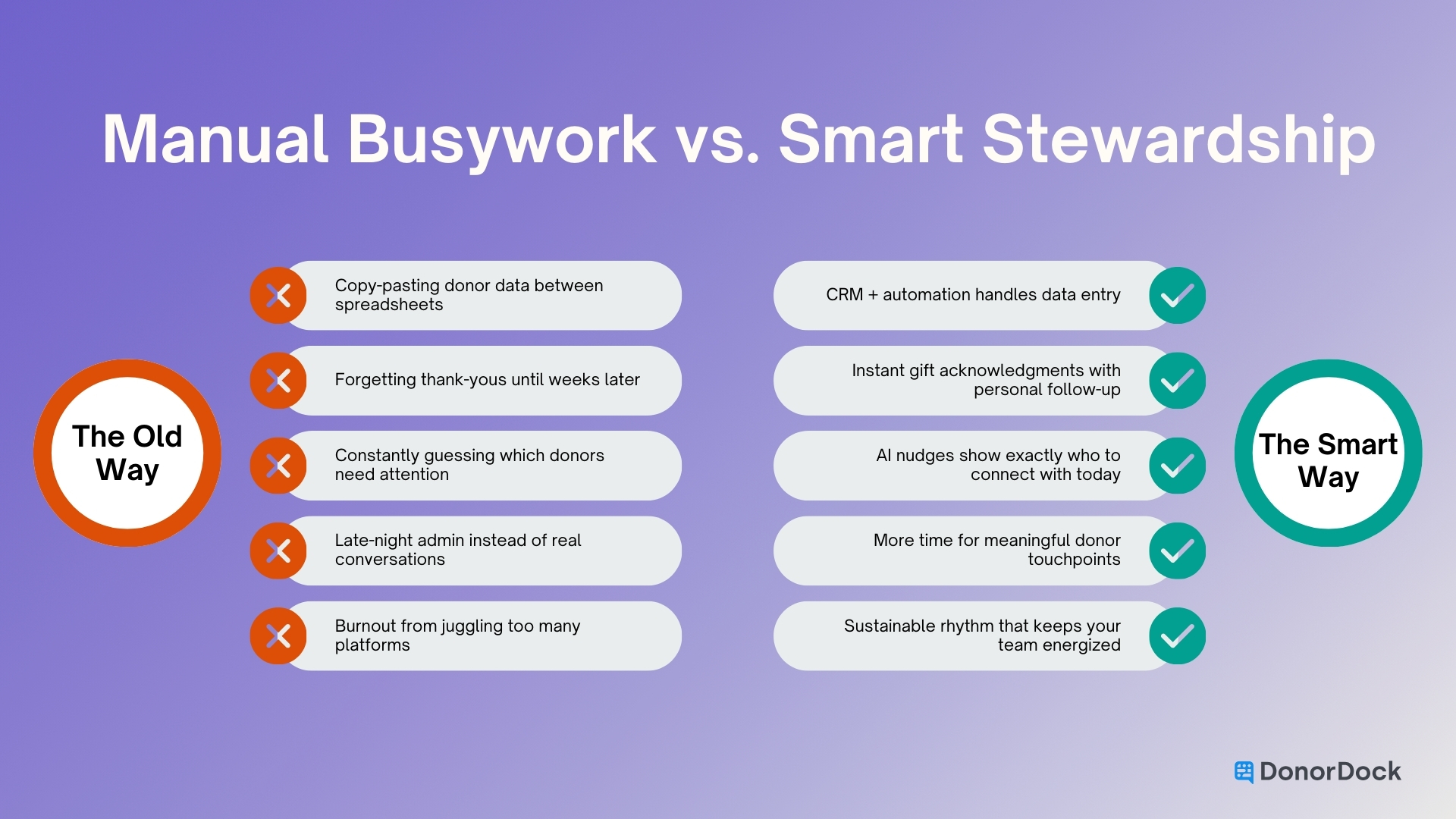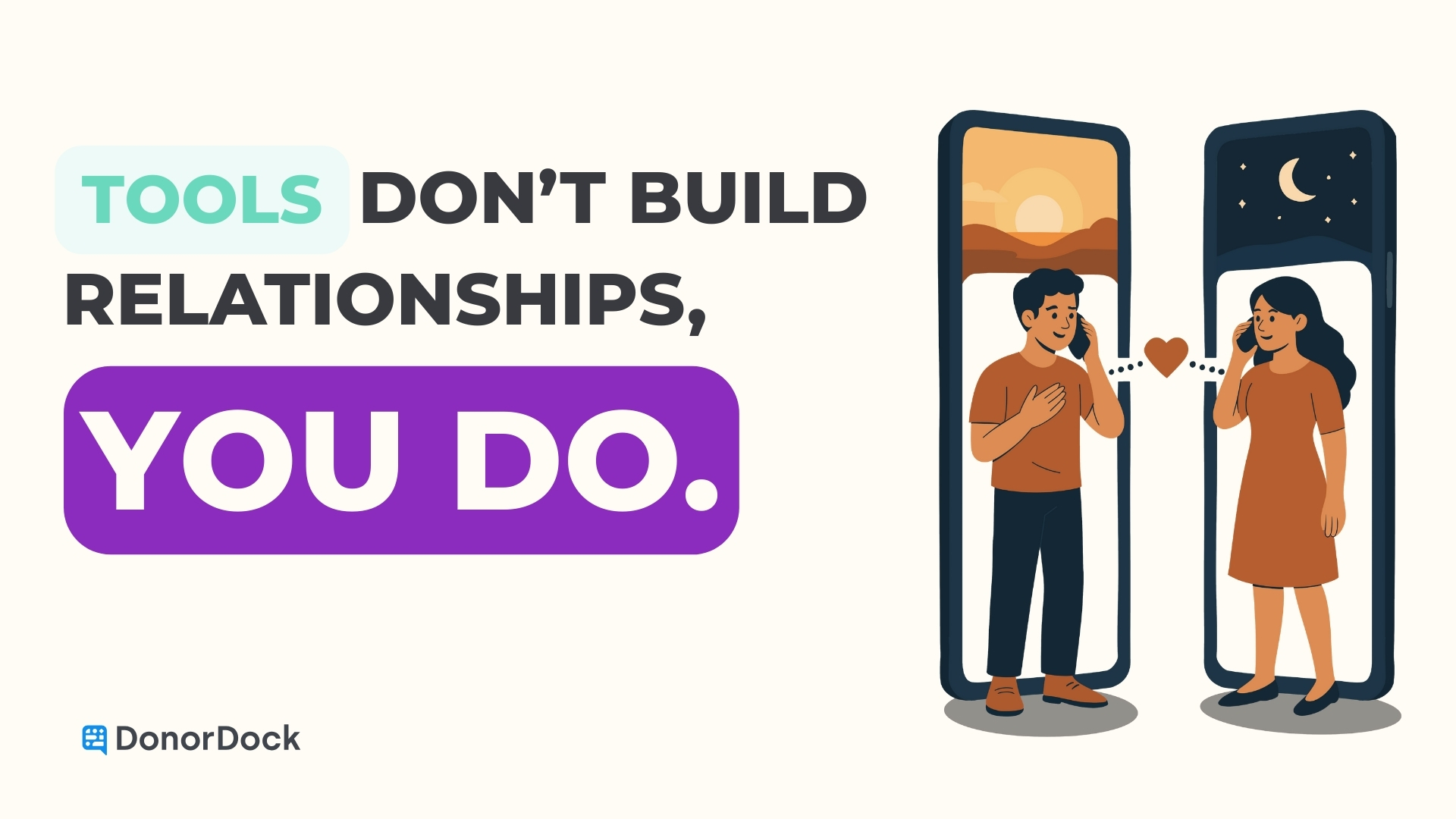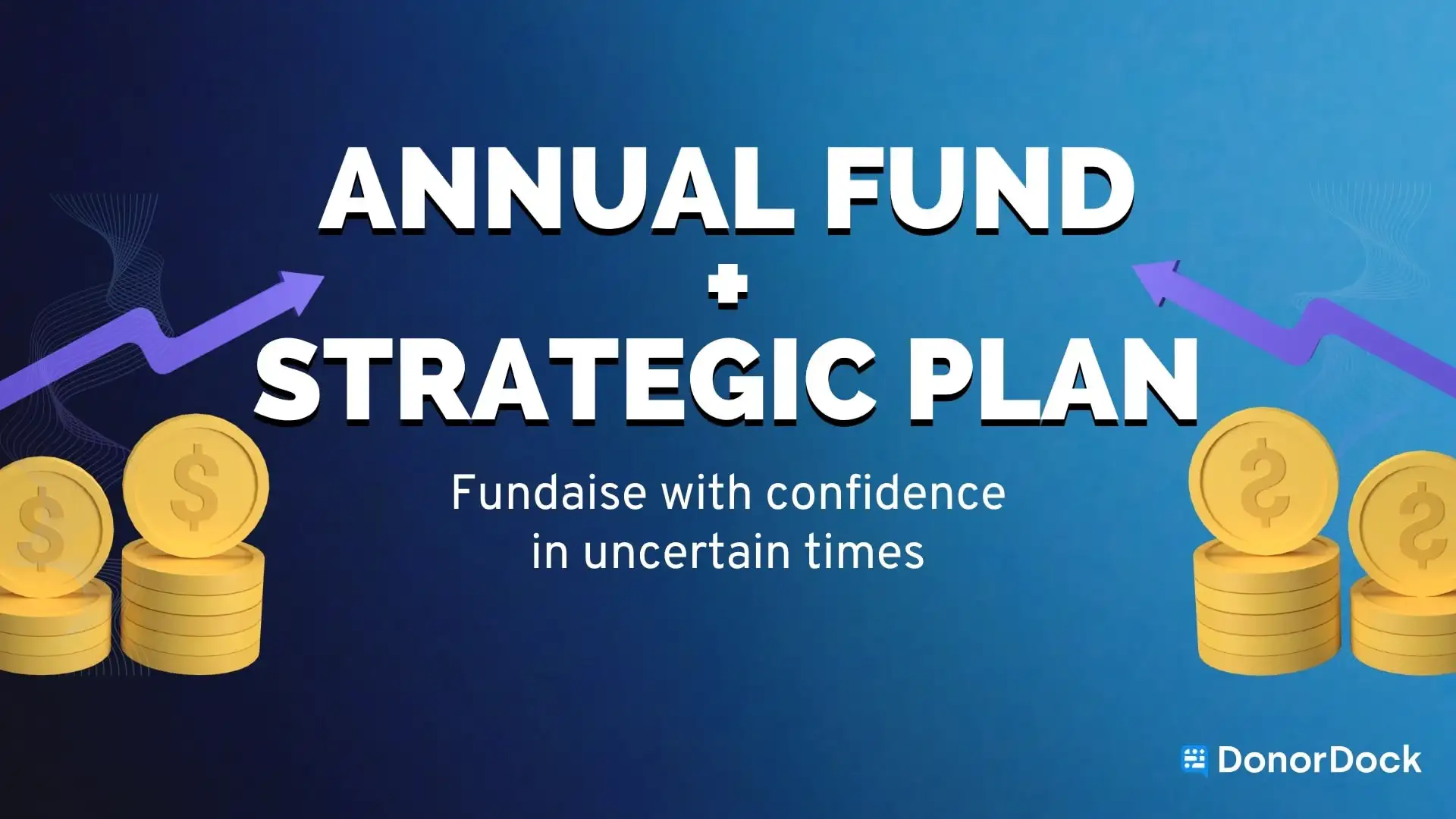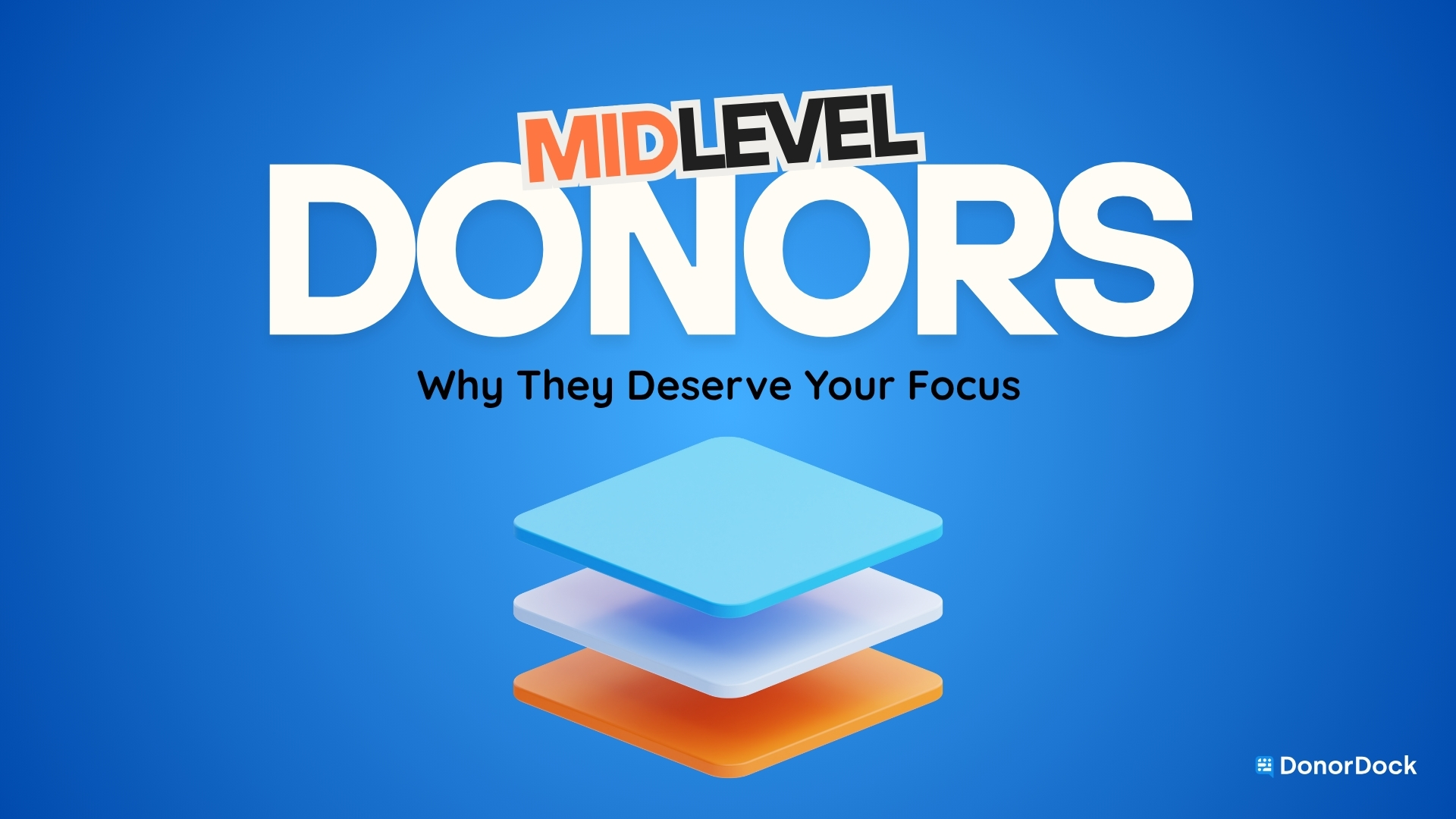Nonprofits are flooded with tools these days. AI platforms, CRMs, donor management apps, marketing schedulers–the list keeps growing. And while tech can be a powerful ally, it can also become another source of overwhelm if you’re not careful.
Here’s the truth: tools don’t build relationships...you do. But the right tools, used wisely, can give you back the time and focus you need to connect meaningfully with your donors.
The Litmus Test for Adopting New Tools
Every shiny new tool comes with a promise: less work, more results. But you’ve probably experienced the opposite at least once. A system that was supposed to help but ended up adding steps, creating confusion, or sitting unused because no one had time to learn it.
Before you add another platform to your nonprofit tech stack, pause and ask: Does this tool buy us more donor time, or does it create more busywork?
Think of it like a kitchen gadget. A good tool is like a sharp knife, simple, reliable, and something you reach for every day. A bad tool is like the fancy avocado slicer you bought and never used, it clutters the drawer and doesn’t actually save time.
To separate the knives from the slicers, apply this three-part test:
- Does it reduce manual labor? If a tool doesn’t cut down on repetitive data entry, calendar juggling, or redundant communications, it’s not worth keeping. Your time should be going into conversations, not into spreadsheets.
- Does it give clarity, not clutter? Tools should help highlight what matters: which donors need attention, which gifts need acknowledgment, and which relationships are at risk. If your CRM leaves you scrolling through endless reports just to figure out your next step, it’s adding stress instead of removing it.
- Does it support, not replace, human connection? AI can draft an acknowledgment email, but only you can make a donor feel seen. If the tool encourages shortcuts that weaken your relationships, it’s not a fit.
This litmus test will save your organization from chasing every new platform that comes along, helping you stay focused on tools that amplify, not replace, human connection.
Tools should amplify, not replace, human connection.
Automating the Mundane: A Stewardship Multiplier

Think about your last week of work. How much of your time was spent having real conversations with donors, and how much was eaten up by paperwork, scheduling, and “quick tasks” that piled into hours?
This is where technology shines. Automation is like having a personal assistant who never forgets, never misses a deadline, and always reminds you of what’s next. Tools like Otto can automatically log donor activity, remind you to follow up, and even alert you when a donor reaches a giving milestone.
Picture this: A first-time donor gives $50. Normally, you’d need to remember to log the gift, generate a thank-you, and then follow up weeks later to see if they’d like to stay connected. With automation, the system immediately sends a warm acknowledgment, flags them for a personal thank-you call, and reminds you in three months to invite them to a recurring gift program. Instead of managing logistics, you’re freed to focus on the conversation.
Automation isn’t about removing the human element. It’s about clearing the runway so you can do what only humans can: listen, empathize, and inspire. As our fundraising automation guide puts it, the goal isn’t to replace your presence, it’s to give you the breathing room to show up more fully.
What You Should Never Outsource to AI
AI is a powerful assistant, but it has blind spots. Imagine receiving a thank-you note that sounds polished but strangely hollow. You’d probably feel less appreciated than if someone wrote you a short, heartfelt message with a few typos.
That’s why some things should always stay human:
- Gratitude. Donors want to know you really appreciate them. A genuine voice carries more weight than a perfect AI draft.
- Vision casting. When you paint the picture of your nonprofit’s future, it’s your passion and conviction that inspire giving—not canned phrasing.
- Listening. No algorithm can sit across from a donor, notice their excitement when they talk about a personal connection to your cause, and respond with empathy.
Technology can suggest, remind, and draft. But the spark that builds trust comes only from you. Automation works best when it handles structure so your heart can handle the rest.
The Data Speaks: Why You Can’t Ignore Retention
One of the strongest arguments for pairing automation with stewardship is donor retention. Acquiring new donors is expensive, and losing them after one gift is like filling a bucket with holes.
- According to Virtuous, many nonprofits hover around a 50% annual donor retention rate—half of donors don’t return year over year (Virtuous).
- NonprofitsSource reports that while 38% of online donors gave again the following year, retention for first-time online donors was only 25% (NonprofitsSource).
The difference between keeping one in four donors and keeping half is massive.
That’s where automated donor journeys shine. Automated donor journeys are simple workflows thatcreate consistency: first gift → thank-you → check-in → impact story → next ask. Instead of leaving retention up to chance, you’re building a thoughtful, repeatable system.
A 5-Task Automation Starter Pack
If you’re ready to start using automation as a true stewardship multiplier, here are five areas that deliver quick wins.
1. Automate gift acknowledgments.
Instead of scrambling to thank donors days later, set up an immediate acknowledgment that lands in their inbox within minutes. Then, schedule yourself a reminder to add a personal touch within 48 hours. Donors feel appreciated twice–once instantly and once authentically.
2. Set reminders for key donor dates.
Imagine calling a donor on the anniversary of their first gift and saying, “We’ve been grateful for your support for three years now.” That kind of detail sticks. Automated reminders for birthdays, anniversaries, or giving milestones make those conversations natural.
3. Use segmentation to guide donor journeys.
First-time donors, recurring givers, and lapsed supporters all need different touchpoints. With segmentation, you can map out nurture tracks for each group. We go into detail on this in 6 donor journeys every nonprofit should use, which shows exactly how to personalize without overcomplicating.
4. Sync data across platforms.
Few things waste more time (or create more errors) than double data entry. Automations that sync your CRM, email platform, and event system ensure everything’s up-to-date, and that you’re not fixing spreadsheets instead of connecting with donors.
5. Leverage AI nudges for donor follow-ups.
Instead of scanning endless reports, imagine opening your dashboard and seeing: “Call Sarah today, she just made her third gift.” That’s the power of Otto. They don’t replace your thank-you call, they make sure you never forget it.
For small teams, these steps are transformative. The goal isn’t to do more with less, it’s to focus on the few things that make the biggest difference.
From Busywork to Relationships
At the end of the day, no CRM, no AI tool, and no automation platform can replace a human relationship. Donors give because they believe in you, your team, and your mission.
The role of technology is simple: to buy back the hours you need for authentic connection.
So the next time you feel tempted to add another “miracle tool” to your stack, ask:
Will this help me know my donors better, or will it bury me in more dashboards?
Because relationships, not software, are what fuel your mission.
Conclusion
The future of fundraising isn’t about choosing between people and technology, it’s about making technology work for people. When you let tools handle the routine and lean into authentic donor connection, you’ll find yourself with more focus, less frenzy, and a stronger foundation for sustainable growth.
Explore more strategies on fundraising automation and donor retention to build a tech stack that truly serves your mission.













